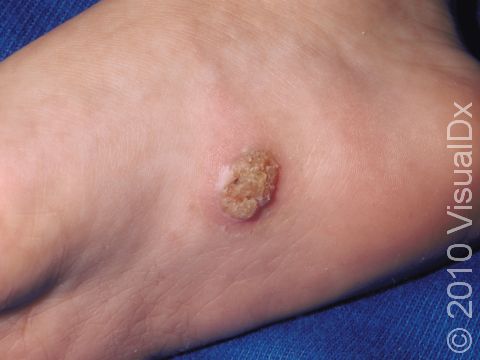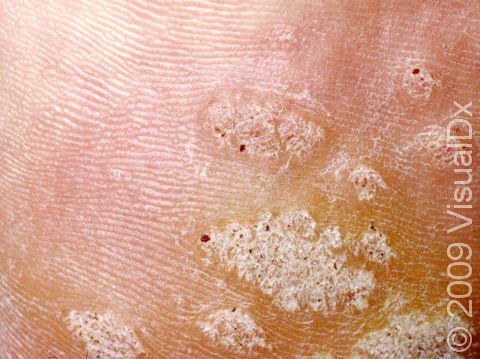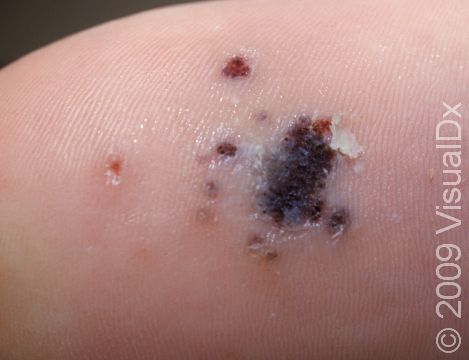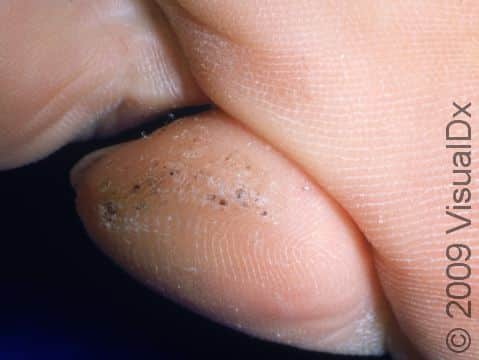Plantar Wart
Warts are growths of the skin and mucous membranes (inside the mouth or genitals) that are caused by a virus known as the human papillomavirus (HPV). Plantar warts occur on the sole of the foot and can feel like a callus. The virus causes thickening of the top skin layer. Plantar warts can be small, or they can grow to cover most of the sole of the foot. They can be painless or may be tender. They can go away on their own, sometimes taking a few months or up to a couple years to resolve.
Warts are usually acquired from person-to-person contact. The virus is not highly contagious but can cause an infection by entering through a small break in the skin. In the same way, warts can be spread to other places on the child’s body (self-inoculation). The virus can sometimes be transferred by touching an object used by an infected person, so it is a good idea for those in the same household to refrain from sharing items such as towels and socks.
Who's At Risk?
Warts can affect people of any age, but they are most common in those aged 12-16 years. It is estimated that 20% of schoolchildren and about 10% of the general population have warts. People with HIV or organ transplants, or those who are on chemotherapy have a higher incidence of warts due to their weakened immune system.
Signs & Symptoms
Warts may occur singly or in groups and often have what appear as multiple small black “dots” at the surface from tiny blood vessels.
Plantar warts are rough, thick, and callus-like, and they often cause tenderness on the soles of the feet, usually on weight-bearing areas.
Self-Care Guidelines
Because warts can resolve on their own, it is not necessary to treat all warts. Additionally, treating warts may not always destroy them, nor will it necessarily keep other warts from appearing. Treatment can be painful, cause scars, and might need to be repeated, so it should only be done in cases where the warts are bothersome or interfere with your child’s daily life.
- Duct tape applied daily to the affected area can help treat warts. The tape should be very sticky and kept on for a few days. Between changes of duct tape, the wart should be soaked in warm water, and any loose skin should be removed every few days with a mild abrasive, like a pumice stone or emery board. Some children may have a reaction to the adhesive on the tape.
- Over-the-counter wart removers contain salicylic acid and work by dissolving away the layer of skin infected with the virus. This treatment needs to be used daily and can sometimes be irritating to the surrounding skin; 40% salicylic acid self-stick pads appear to be one of the most effective types. Keep each pad on for 2-3 days. Remove the pad and tape, and scrub away the top layer of dead skin, now white-colored, with an emery board or pumice stone. Reapply a new 40% salicylic acid pad. Keep removing dead skin and reapplying every few days until the wart is gone. Many plantar warts will respond in 1-2 months.
- Over-the-counter freezing medications are available but have not been found to be very effective.
- Family members should avoid sharing personal items such as towels.
Treatments
- Application of podophyllin, tretinoin, or acid
- Destruction with freezing (cryosurgery), burning (electrocautery), or laser. These treatments are painful, though, and may be avoided in younger children.
Visit Urgency
See your child’s medical professional if they have:
- Painful or bleeding warts.
- Warts interfering with daily life that do not improve with self-care.
References
Bolognia J, Schaffer JV, Cerroni L. Dermatology. 4th ed. Philadelphia, PA: Elsevier; 2018.
James WD, Elston D, Treat JR, Rosenbach MA. Andrew’s Diseases of the Skin. 13th ed. Philadelphia, PA: Elsevier; 2019.
Kang S, Amagai M, Bruckner AL, et al. Fitzpatrick’s Dermatology. 9th ed. New York, NY: McGraw-Hill Education; 2019.
Paller A, Mancini A. Paller and Mancini: Hurwitz Clinical Pediatric Dermatology. 6th ed. St. Louis, MO: Elsevier; 2022.
Last modified on June 14th, 2024 at 12:38 pm

Not sure what to look for?
Try our new Rash and Skin Condition Finder



